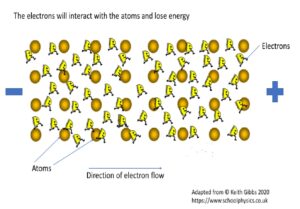Topological materials are a new ‘quantum’ class of materials that are being investigated for their use in the next generation of energy-efficient electronics.
Why are researchers excited about topological materials?
Topological insulators behave as electrical insulators in their interior, but they will conduct a current along their edges. They can conduct this current without resistance and therefore with no loss of energy. All conductors that we use today such as copper and gold display some resistance. This means a lot of the energy we generate is wasted. You can feel this loss as heat when you use your laptop or phone.
Energy used for computation accounts for about 10% of the global energy consumption, and that consumption rate is doubling every decade. Research groups worldwide, including FLEET, are therefore putting immense efforts into understanding topological insulators for their potential use in low-energy electronics.
Given that energy used for computation accounts for about 10% of our global energy consumption, a figure doubling every decade, a technology that can help reduce energy loss through the development of low-energy electronics such as computers has meant topological insulators have become the focus of serious research worldwide. Indeed, it is one of FLEET’s core research themes.
Topological materials in transistors
The transistor is that tiny on/off switch that sits with billions of other transistors on your computer chip. Together they are the brains of your computer, that is, they are responsible for all the computations done by computers. Today’s transistor relies on silicon as its semi-conducting material, but if we are to reduce the energy consumption of computers then we need to construct and use a new material that can conduct without energy loss.
“We expect that topological transistors could replace conventional semiconductor transistors and use much less energy for the same size transistor,” says FLEET director Professor Michael Fuhrer1
Resistance (is futile)
Electrical resistance is a property of a material that impedes the flow of electrons. It is resistance that makes insulators such poor conductors of an electrical current and the greater the resistance of a material, the more energy is required to get electrons to flow through that material. Even the best conductors, however, have some level of resistance.
Resistance can come from the electrons’ interaction with other atoms in the material where the energy of the electrons is transferred into kinetic energy as it bounces off each atom, which then becomes heat and energy lost from the system. See Figure 1. Furthermore, the strength of an electron’s bond to its atom will differ with each type of atom (ie, with different materials). Stronger bonds require more energy for electrons to break the electron free and become mobile to move through a circuit and generate current. The stronger the bond, the greater the resistance.
And this is where topological insulators get interesting. In normal conductors, electrons flow through the interior of the material and therefore encounters lots or resistance. Because topological insulators conduct only around their edges, the electrons avoid interactions with other atoms and conduct with zero or almost zero resistance and therefore minimal energy loss.
Figure 1. Electrical resistance occurs as electrons, travelling through a material, interact with atoms. The electrons lose some of their energy as heat.
Extend your thinking: Topology
Topology is the branch of mathematics that explores the nature of shapes independent of deformation. Or more simply the mathematics of shapes and holes. That is, two objects or shapes are considered to be the same if they can be deformed from one into the other by bending, twisting, stretching or shrinking. Deformation, however, does not include ripping the object apart, sticking other bits on, or poking new holes.
A famous example in topology is the similarity between a cup and a donut under continuous deformation. A topologist will consider the cup and donut the same thing. See Figure 2. In terms of topology, the cup and donut belong to the same class, denoted by the single hole in their body. Since there is no half hole, or any fraction of hole, we only need to use an integer to distinguish different types of forms.
For FLEET, the interesting aspect of topology is that some of the properties of the material (ie its topological order) remain the same before and after deformation. In the case of topological insulators, the properties that remain unchanged are their insulative and conducting properties.
Figure 2. The magic of topology. For topologists, the mug and donut are the same thing because they can be deformed from one to the other without the need to add bits, poke new holes or rip bits off. A solid ball, however is not the same as a donut or mug (with handle) because the solid ball cannot become a donut or mug without poking a hole in it.
Hairy ball theorem
Topology is also useful to help us understand about how the world works, for example why there will always be somewhere on Earth where the wind does not blow.
References
1 Professor Michael Fuhrer IEEE article
More information
MIT News 31 October 2018. First two-dimensional material that performs as both topological insulator and superconductor
Acknowledgement: Thanks to FLEET’s Edward Liu for all the technical expertise in putting this article together.
Back to FLEET Schools



